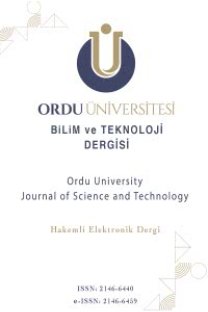Kristallenmiş Çiçek Balının Sıvılaşma Hızının Artırılmasının Deneysel İncelenmesi
Ballar arı kolonisinden hasat edildikten sonra mekanizasyonla bal peteğinden çıkarılarak kutu veya fıçılarda sıvı olarak depolanmaktadır. Balın kimyasal yapısı, türü ve içerdiği yabancı maddeler veya ortam sıcaklığına bağlı olarak bal kristalize olmaktadır. Türkiye’de genel olarak sıvı (wax) bal kristalize olarak tüketilmemektedir. Bu nedenle bal tekrar sıvılaştırılarak paketlenmektedir. Dikdörtgen prizma kutularda depolanan bal kristalleşdiğinde sıvılaştırma ortamı olarak genellikle havalı fırın veya sıcak su havuzu kullanılmaktadır. Balın sıvılaşma süresi balın tipine, sıvılaşma ortamına, ortam sıcaklığına ve bal kabının geometrisine bağlıdır. Ortam sıcaklığı ve sıvılaşma süresi arttıkça balda hem kimyasal hem de renk ve tat değişimleri olmaktadır. Bu deneysel çalışmada, dikdörtgen prizma kutularda (18 dm3) depolanan kristarilize bal 50 oC’deki havalı tip fırında sıvılaştırılması iki farklı yöntem (geleneksel ve mekanik titreştirici) ile gerçekleştirildi. Sıvılaşma sırasında balın x ve y eksenlerinde zamana bağlı sıcaklık değişimi belirlenmiştir. Isıl işlem görmüş balın içeriğindeki nem, diastaz, prolin ve HMF (Hidroksimetilfurfural) değişimleri ölçülmüştür. Elde edilen veriler sonucunda mekanik titreşimli sıvılaştırma süresi geleneksel sıvılaştırma süresine göre %35 daha kısa olduğu tespit edilmiştir. Her iki yöntem ile yapılan ısıl işlem sonunda baldaki kimyasal değerlerin değişimi Türk Gıda Kodeksine uygun olduğu görülmüştür.
Anahtar Kelimeler:
çiçek balı, kristalizasyon, balın özellikleri, sıvılaştırma metotları, mekanik titreşim
Experimental Investigation of Increasing the Liquefaction Velocity of Crystallized Flower Honey
After the honey is harvested from the bee colony, it is removed from the honeycomb with mechanization and stored as a liquid in cans or barrels. Honey crystallizes depending on the chemical structure, type of its, and impurity or ambient temperature. In Turkey, liquid (wax) honey is generally not consumed as crystallized. For this reason, honey is liquefied and packaged again. When the honey crystallizes, which is stored in tin cans, an air oven or hot water pool is usually used as a liquefaction medium. The liquefaction time of honey depends on the type of its, melting medium, the ambient temperature, and the geometry of the honey container. As the ambient temperature and melting time increase, both chemical and color-taste changes occur in honey. In this experimental study, crystallized honey stored in tin cans (18 dm3) was liquefied in an air-type oven at 50oC using two different methods (conventional and mechanical vibratory). During liquefaction, time-dependent temperature changes were determined in honey’s x and y axes. Moisture, diastase, proline, and HMF (Hidroksimetilfurfural) changes in the heat-treated honey were measured. As a result of the obtained data, it was determined that the mechanical vibration liquefaction time was 35% shorter than the conventional liquefaction time. At the end of the heat treatment with both methods, the change of chemical values in honey was found to be in accordance with the Turkish Food Code.
Keywords:
flower honey, crystallization, characteristics of honey, liquefaction methods, mechanical vibration,
___
- Bogdanov, S., Ruoff, K., & Oddo, L. P., (2004). Physico-chemical method foor the characterisation of unifloral honeys: A review. Apidologie, 35, 4-17. https://doi.org/10.1051/apido:2004047
- De Lucia, M., & Bejan, A. (1990). Thermodynamics of energy storage by melting due to conduction or natural convection. J. Solar Energy Eng., 112(2), 110-116. https://doi.org/10.1115/1.2929642
- Ghazali, H. M., Ming, T. C., & Hashim, D. M. (1994). Effect of micro-wave heating on the storage and properties of starfruit honey. ASEAN Food Journal, 9(1). 30–35. http://agris.upm.edu.my:8080/dspace/handle/0/5162
- Güney, F. (2010). Isıtma ile balın yapısında meydana gelen olumsuz değişiklikler. Ordu'da Gıda Güvenliği Dergisi, 11, 30-34. https://arastirma.tarimorman.gov.tr/aricilik/Belgeler/makale/faz%C4%B1l2010_1.pdf
- Hebbar, H. U., Nandini, K. E., Lakshmi, M. C., & Subramanıan, R. (2003). Microwave and infrared heat processing of honey and its quality. Food Science and Technology Research, 9(1), 49-53. https://doi.org/10.3136/fstr.9.49
- Kabbani, D., Sepulcre, F., & Wedekind, J. (2011). Ultrasound-assisted liquefaction of rosemary honey: Influence on rheology and crystal content. Journal of Food Engineering, 107(2), 173-178. https://doi.org/10.1016/j.jfoodeng.2011.06.027
- Ouchemoukh, S., Louaileche, H., & Schweitzer, P. (2007). Physicochemical characteristics and pollen spectrum of some Algerian honeys. Food Control, 18, 52–58. https://doi.org/10.1016/j.foodcont.2005.08.007
- Pal, D., & Joshi, Y. (2001). Melting in a side heated tall enclosure by a uniformly dissipating heat source. International Journal of Heat and Mass Transfer, 44(2), 375-387. https://doi.org/10.1016/S0017-9310(00)00116-2
- Sandhu, C. (1986). Infrared radiative drying in food engineering: A process analysis. Technol. Prog., 2. 109–119. Thrasyvoulou, A., Manikis, J., & Tselios, D. (1994). Liquefying crystallized honey with ultrasonic waves. Apidologie, 25, 297-302. https://doi.org/10.1051/apido:19940304
- Yao, L., Bhandri, B. R., Datta, N., Singanusong, R., & D’Arcy, B. R. (2003). Crystallisation and moisture sorption properties of selected australian honeys. Sci Food Agric., 83, 884-888. https://doi.org/10.1002/jsfa.1421
- ISSN: 2146-6440
- Yayın Aralığı: Yılda 2 Sayı
- Başlangıç: 2011
- Yayıncı: ORDU ÜNİVERSİTESİ
Sayıdaki Diğer Makaleler
Ordu İli Fatsa İlçesi Jeotermal Enerji Potansiyelinin Isıtma Sistemlerinde Kullanımı
Tuncay ŞAHİN, Mehmet Sami GÜLER, İlhan Volkan ÖNER
Kristallenmiş Çiçek Balının Sıvılaşma Hızının Artırılmasının Deneysel İncelenmesi
Flutriafol ve Triflorlanmış Analoğunun HOMO-LUMO, ESP, NBO ve Lipofilik Karakter Analizleri
Fatma Dilay AHA, Faruk ÖZKUTLU
Karadeniz Bölgesi Meteoroloji Gözlem İstasyonlarının Rüzgâr Hızı Değerleri Kullanılarak Kümelenmesi
Gürkan KIR, Aslı ÜLKE KESKİN, Utku ZEYBEKOĞLU
Gemlik Zeytin Çeşidinde Sulama ve Gübrelemenin Meyve Kalitesi Üzerine Etkileri
